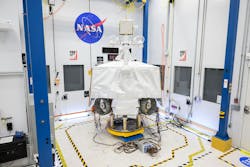NASA gauges industry interest in using VIPER lunar rover for Moon missions
WASHINGTON - The National Aeronautics and Space Administration (NASA) announced it is looking for industry partners interested in utilizing the agency's Volatiles Investigating Polar Exploration Rover (VIPER) on the Moon for its own missions.
NASA's VIPER mission is intended to provide direct observations and insights into the composition, distribution, and quantity of volatiles in the Moon's south polar region. The mission is planned to last 100 Earth days on the lunar surface, with the rover capable of enduring up to 50 hours of darkness on a full charge and conducting approximately nine hours of operations in Permanently Shadowed Regions (PSRs), which are highly likely to contain water ice and other volatiles.
The fully assembled rover weighs around 500 kg, measures approximately 1.5m x 1.5m x 2.0m, and has sufficient battery capacity to survive multiple lunar day-night cycles by utilizing strategic hibernation spots.
Related: NASA selects Moog to power and control VIPER lunar rover
VIPER is equipped with various instruments, including a neutron spectrometer, a near-infrared spectrometer, a mass spectrometer (MSolo), and a drill system. A full list of technologies and capabilities is available at https://science.nasa.gov/wp-content/uploads/2024/08/viper-pip-final.pdf.
Any partners would begin with the existing VIPER rover and be responsible for completing any remaining systems-level testing, coordinating the integration and successful landing on the Moon, conducting a science and exploration campaign, and openly sharing the science data. U.S.-based partners would also need to provide the necessary resources to complete the mission from the hardware's current state and reimburse NASA for the use of any NASA capabilities, which includes additional testing, anomaly resolution activities, payload preparation, and processing support, or support from science/instrument/operations teams. The goal is for any partnership to incur minimal or no additional costs to NASA. If NASA decides to proceed with this approach, partners would not be allowed to disassemble and use VIPER's instruments or parts separately from a VIPER mission.
Interested parties are asked to submit required documents by 11:59 p.m. EDT on 2 September 2024. This request for information's primary point of contact is Brad Bailey, assistant deputy associate administrator for exploration, and can be reached at [email protected]. More information is available at https://sam.gov/opp/31284effc2ba4da4978a6dde931b6250/view.
About the Author
Jamie Whitney
Senior Editor
Jamie Whitney joined the staff of Military & Aerospace Electronics in 2018 and oversees editorial content and produces news and features for Military & Aerospace Electronics, attends industry events, produces Webcasts, and oversees print production of Military & Aerospace Electronics.
